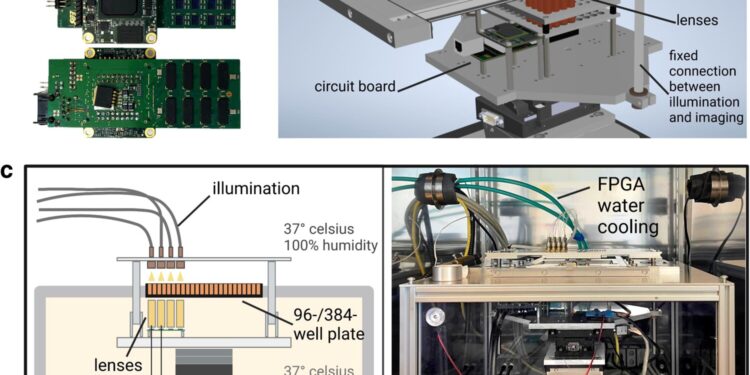a: Top view of the lenses with one lens removed to allow zooming on the underlying CMOS imager. Below: photographs of the circuit board with imagers and FPGA from top to bottom. b 3D model of the ComplexEye outside the division chamber (see also Supplementary Movies 1 and 2). c Left: Schematic overview of the components and structure of the ComplexEye inside the temperate cabin with the division into dry and humid climatic zones. Right: Photograph of the actual ComplexEye corresponding to the view shown in the diagram (left). FPGA Field Programmable Gate Array Credit: Natural communications (2023). DOI:10.1038/s41467-023-43765-3
Immune cells, for example, fight infectious intruders or search for emerging cancers. They therefore constantly migrate through the tissues of our body. But in the wrong place, immune cells like neutrophil granulocytes can cause damage. If these white blood cells infiltrate tumors, this is often associated with a poor prognosis for patients. This is why they could benefit from drugs that prevent neutrophils from migrating to tumors.
Until now, this migration has been studied by conventional video microscopy. Researchers (University of Duisburg-Essen, Leibniz-Institut für Analytische Wissenschaften) have developed a microscope for the high-throughput analysis of compounds.
With conventional video microscopy, a single camera lens observes the movement of cells under the microscope, one sample at a time. With their new microscope, scientists from the University of Duisburg-Essen (UDE) and the Leibniz-Institut für Analytice Wissenschaften (ISAS) can analyze several samples simultaneously. The researchers present their microscope, named ComplexEye, in Natural communications.
“If we knew how to control neutrophil migration, many diseases would be easier to treat,” says Professor Matthias Gunzer, director of the Institute for Experimental Immunology and Imaging (UDE) and head of the Department of Biospectroscopy at ISAS. But until now, there has been a lack of methods to advance this type of research, particularly for small, fast-evolving immune cells. Now, Gunzer and his co-authors have been able to significantly increase the speed of migration analyzes using ComplexEye.
60 times faster than conventional microscopes
“In our tests, we were able to analyze the samples around 60 times faster than with conventional video microscopy,” explain the two lead authors Zülal Cibir and Jaqueline Hassel (UDE).
To study the influence of existing compounds on neutrophil migration, the Essen researchers tested around 1,000 substances from a chemical library at the Lead Discovery Center in Dortmund. For the subsequent analysis, AI experts at ISAS programmed custom software.
Using the AI-supported ComplexEye system, in just four days, researchers then identified 17 substances that could strongly influence the mobility of human neutrophils.
Initially, the results have fundamental scientific value, but researchers hope they will pave the way for many new treatment options. “With some minor adjustments, ComplexEye can also be used for other cells, for example to monitor the progression of diseases and detect warning signs of worsening infections, such as impending blood poisoning,” explains the immunologist Gunzer.
About ComplexEye
To develop ComplexEye, scientists from the Faculty of Medicine, the Department of Electrical Engineering and Information Technology at UDE and ISAS in Dortmund worked closely together.
“The challenge was to build miniaturized microscopes, make them mobile and assemble them so tightly into a single system that they could record video from each of the 384 chambers in a well plate, a common examination tray” , explains Dr Reinhard Viga from the Electronics Division Components and Circuits at UDE.
The electrical engineer was responsible for the technical construction of the new microscope. Like a fly’s multi-lens compound eye, ComplexEye moves beneath the well plate and simultaneously takes images with all of its lenses every eight seconds.
Researchers then combine these images to create time-lapse sequences. The migrating cells visible in these films are then tracked individually by the AI. In the future, ComplexEye will be expanded to include additional lenses so that even more images can be captured.
More information:
Zülal Cibir et al, ComplexEye: a multi-lens microscope for integrated analysis of high-throughput immune cell migration, Natural communications (2023). DOI: 10.1038/s41467-023-43765-3
Provided by Leibniz-Institut für Analytische Wissenschaften
Quote: Multi-lens microscope and AI enable faster analysis of immune cell migration (December 11, 2023) retrieved December 11, 2023 from
This document is subject to copyright. Apart from fair use for private study or research purposes, no part may be reproduced without written permission. The content is provided for information only.



